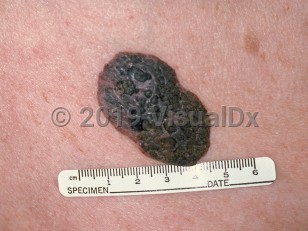Seborrheic keratosis - Anogenital in
See also in: Overview,External and Internal Eye,Hair and ScalpSynopsis

SKs tend to increase in incidence and number with increasing age. SKs are asymptomatic, but when irritated or traumatized, they may become pruritic or painful with associated redness or bleeding.
SKs rarely arise on penile skin. SKs in the genital area have been associated with the presence of human papillomavirus (HPV) infection as identified by polymerase chain reaction (PCR).
An SK may start out as a flat, wrinkled plaque with a "postage stamp" appearance (flat SK).
A lichenoid keratosis is an inflamed SK that presents as a pink, shiny papule or plaque with an appearance that resembles that of nodular or cystic basal cell carcinoma (BCC) or melanoma.
Melanoacanthoma is an SK subtype characterized by more hyperpigmentation and less hyperkeratosis and often requires a biopsy for definitive diagnosis given the degree of pigmentation.
Relatively rapid onset (within weeks to months) of numerous SKs may be a cutaneous sign of internal malignancy. Multiple eruptive SKs in association with a visceral cancer is referred to as the sign of Leser-Trélat. The most common associated malignancy is adenocarcinoma of the gastrointestinal tract; other associated malignancies include lung cancer, esophageal carcinoma, mycosis fungoides, and Sézary syndrome.
Codes
L82.1 – Other seborrheic keratosis
SNOMEDCT:
25499005 – Seborrheic keratosis
Look For
Subscription Required
Diagnostic Pearls
Subscription Required
Differential Diagnosis & Pitfalls

Subscription Required
Best Tests
Subscription Required
Management Pearls
Subscription Required
Therapy
Subscription Required
Drug Reaction Data
Subscription Required
References
Subscription Required
Last Updated:08/05/2025
 Patient Information for Seborrheic keratosis - Anogenital in
Patient Information for Seborrheic keratosis - Anogenital in - Improve treatment compliance
- Reduce after-hours questions
- Increase patient engagement and satisfaction
- Written in clear, easy-to-understand language. No confusing jargon.
- Available in English and Spanish
- Print out or email directly to your patient


